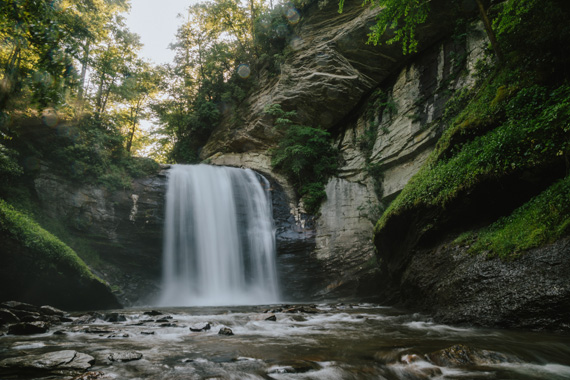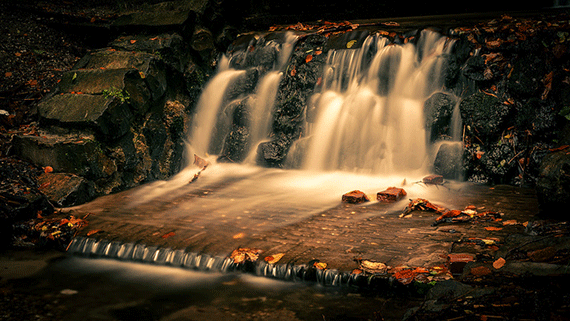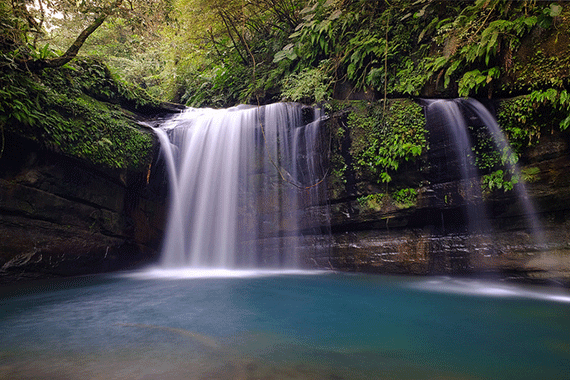I love water. Coming from Ontario where lakes and rivers abound, I’d spend entire summers at our cottage as a kid either in or on the water. I’m still drawn to it like steel to a magnet, so it’s not surprising that after learning the technique to create the beautiful pictures like in this article, I was shooting every waterfall I could find!

Photo by Wes Hicks; ISO 100, f/22.0, 0.6 sec, 24mm.
If you have waterfalls in your area, or are planning a trip where you will have access to waterfalls, rapids, etc, keep the following few tips in mind for some beautiful and dramatic captures.
As mentioned in my article How to Shoot Fireworks, a tripod is at the top of the list for equipment, including a remote cable release. Mirror lock-up is good if your camera has it. The reason for all this is that we’re aiming for that silky, surreal effect, which requires the shutter to be open one second or more.
Some important factors are film speed, or ISO setting if you’re shooting digital. Because we want a nice long exposure, ISO 100 or lower is ideal. An overcast sky is best, as it provides diffused light, as opposed to the harsh shadows and highlights of direct sunlight. Filters are important here too: see the list just below.
In the end, all these elements work nicely together to get the ideal shutter speed of two to five seconds, possibly more.
For equipment, you’ll need a…
- good SLR that you can put into either manual or aperture priority mode.
- tripod.
- neutral density filter, and filter holding system such as Lee or Cokin.
- polarizing filter.
- remote cable release for the camera.
So the setup goes as follows: find a nice composition of your water subject, which doesn’t have to be a full-frame of the entire waterfall, as sometimes just a small portion of it is all you need for an effective and beautiful shot. And, it doesn’t have to be an actual full-blown waterfall – any water moving over rocks and such still come out beautiful with this technique. Set your tripod at its lowest possible height for stability, and if it’s windy, hang your camera bag off it to add weight.

Photo by Dennis Burger; ISO 100, f/11.0, 30-second exposure.
The f-stop should be set for maximum depth of field, not only to maintain focus across the entire image, but also to minimize the amount of light entering your camera – remember, we’re looking for a long exposure. A setting of f-22 may cause a slight bit of blurriness due to light fringing. Photons actually bend a slight bit around sharp edges (i.e. your camera’s aperture blades), so you’ll need to experiment. Perhaps f-13 or f-19 will best suit your lens.
Adjust the polarizing filter to eliminate as much reflection as possible, then take a reading of the subject with your camera in aperture priority, noting the shutter speed. If it’s too fast, then you will want to either stop down the aperture, and/or add a neutral density filter or two. I carry a one-stop as well as a two-stop, so not only do I have the choice of a one or two stop reduction in light, but if I stack them, I can get three stops of light reduction which is great for those really long exposures.
So, you’ve composed your image, and found the right combination of f-stop and filters to achieve the ideal shutter speed. There are two techniques for firing the shutter. If you keep the camera in aperture priority, and move your face away from the camera to trip the shutter with your remote cable, your exposure will be incorrect. Light entering the eyepiece affects the in-camera metering, so either keep your eye in the eyepiece, or cover it with your hand when firing the shutter.
The other method it to note the shutter speed when composing, put the camera into manual mode, and set the shutter to that metered value. You can then back off from the camera and trip the shutter with no worries about the camera changing any settings on you. If you happen to have forgotten your remote cable at home (which I’ve done more than once), just use the camera’s timer feature. That way, you’re not jiggling the camera when the shutter fires.
A quick word about image stabilizing technology: whether it’s in the camera or in your lens, turn it off unless the manufacturer says it’s designed to be activated while on a tripod. Some even sense when they’re on a tripod, and dampen mirror slap, such as Canon’s 70-200 f2.8L IS USM lens. Otherwise, leaving it on actually will blur your image.

Photo by jack.chih; ISO 200, f/11.0, 20-second exposure.
So, experiment with your settings. Play with longer and shorter shutter speeds, under and over exposing, etc. You will then get a good feel for your camera’s capabilities, which leads to more beautiful pictures to add to your collection. Although this is a technique used to create many images you see in coffee table books, etc, it’s still a satisfying experience creating your very own!
Enjoy!
About the Author:
James Hutchison is a graduate of the New York Institute of Photography, and a member of the National Association of Photoshop Professionals.
- - - - - - - - - - - - - - - - - - - - - - - - - - - - - - - - - - - - - - - - - - - - - - - - - - - - - - - - - - - - - - - - - - - - - - - - - -
Did you appreciate this newsletter? Please help us keep it going by Joining Our Patreon Supporters
What are your thoughts on this article? Join the discussion on our Facebook Page
PictureCorrect subscribers can also learn more today with our #1 bestseller: The Photography Tutorial eBook
- - - - - - - - - - - - - - - - - - - - - - - - - - - - - - - - - - - - - - - - - - - - - - - - - - - - - - - - - - - - - - - - - - - - - - - - - -
The post How to Photograph Waterfalls appeared first on PictureCorrect.
from PictureCorrect https://ift.tt/Q3uEvXs
via IFTTT






0 kommenttia:
Lähetä kommentti